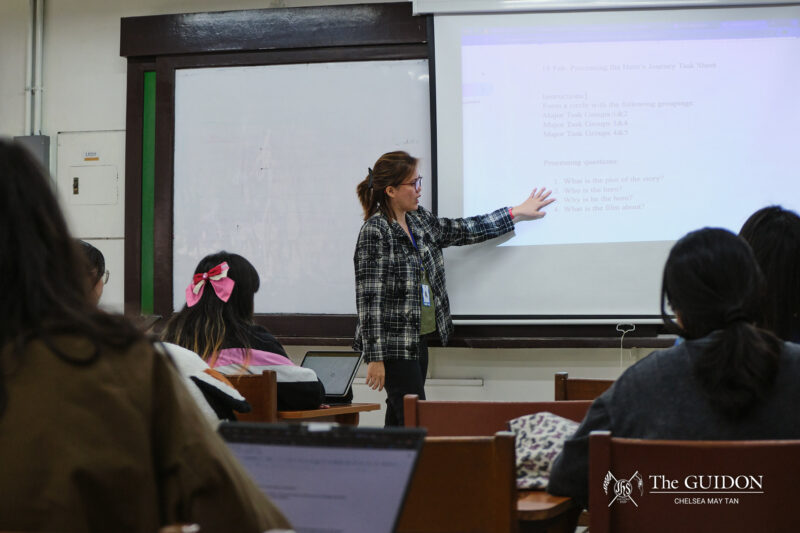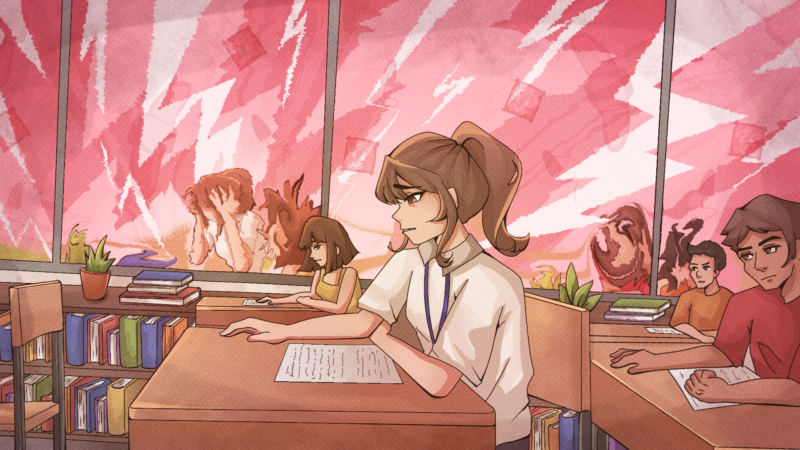Gabriella*, like other college students, deals with academic stress, family problems, and financial difficulties. She, however, has a different way of dealing with them.
“I locked the door to my room and took the key with me inside. I tied a rope around my neck,” she says. “This was my first suicide attempt, back in grade five.”
Gabriella is just one of the many young people who consider suicide the solution to their problems.
In the first semester of this school year alone, the Ateneo itself has grieved over three suicides, including one by a law school graduate. But the problem is not unique to this university. According to the World Health Organization (WHO), global suicide rates have increased by 60% in the past 45 years. Adolescent suicides have prompted concern from many school officials worldwide.
With cases of student suicide on the rise, the typical Atenean is just as at risk as any university student in the world.
Gender-specific
According to WHO’s September 2008 bulletin, suicide methods vary according to gender. Men often use more lethal forms of committing suicide, such as the use of firearms and hanging. Meanwhile, women prefer methods like poisoning by pesticide or drugs and drowning. Other methods of suicide include jumping from a height, exsanguination (slitting the arteries), suffocation, electric shock, and carbon monoxide poisoning.
In the late 1990s, firearms accounted for most youth suicides, followed by hanging. By 2004, death by hanging became the most common method because of its accessibility.
Tormented soul
For Gabriella, it is only normal that when one is tormented by pain, one would want it to end. “If you can’t find something to stop the pain, that’s when you realize [that] the only way to stop the torment is to finish off the tormented soul.”
She recounts how her relatives have always seen her as a “strange monstrosity” who can’t do anything right. They would always tell her to behave in a certain way and be a different person altogether. But what drove her to the edge were comparisons her relatives made of Gabriella and her best friend.
Unlike Gabriella, her best friend was an honor student often praised for her good grades and nice personality. “When placed next to me, [she] shone like the Virgin Mary,” she says. “[My relatives] would always tell me, why can’t you be like her?” Being constantly compared with other more successful people led her to begin her series of suicide attempts.
Though Demi* didn’t attempt to commit suicide, she deliberately injured herself during her high school senior year. She threw herself over objects with hard surfaces. She also didn’t eat so she would have to get sick and, thus, wouldn’t have to go to school.
“My [friends] left me because of a guy,” she says. Liked by a boy that a friend was attracted to, Demi found herself shunned by her entire class. What hurt her, she says, was that she wasn’t given a chance to explain herself.
“Being friendless was absolutely the last way I wanted to spend my last year of high school. It was so horrible and my mom wouldn’t let me transfer schools. I wanted to die so badly.”
Emotional turmoil
According to Psychology Department Associate Professor Emma Liwag, Ph.D., many cases of suicide are linked to individuals suffering from emotional disorder. “Suicide is something that has been associated with certain very deep-seated emotional or mental problems, specifically depression.”
As defined by WHO, depression is a common mental disorder characterized by a “depressed mood, loss of interest or pleasure, feelings of guilt or low self-worth, disturbed sleep or appetite, low energy, and poor concentration.” When left untreated, it can claim about 850,000 lives through suicide every year. According to Reuters, it is the leading cause of suicide among young people worldwide.
Not all cases of suicide, however, are caused by a psychological disorder. According to Liwag, the decision to stop living consists of many other complex factors. “We cannot assume that when a person commits suicide, it was because he was mentally ill or emotionally disordered,” she says. “There are people with full rational faculties [who] still make the decision to end their lives.”
According to WHO, young people are now at the highest risk of suicide in a third of all countries, surpassing the traditionally high suicide rates among the male elderly (about 52 deaths per 100,000 for white males).
Liwag believes that this is because the youth’s coping and problem-solving skills are not yet fully developed. In dealing with the same problems that an older person might face, the younger one might not see other options in solving them. “When experiencing deep pain, the young person might think that the only way to end that pain is to end [the] life that bears this pain.”
Stress isn’t always the cause
Changes in lifestyle over the years may have also contributed to the increase in suicide cases. With their fast-paced lifestyles, many young people could be overwhelmed with the burden of possibilities.
“The lives of young persons today [are] probably [a] very far [cry] from the lives of young persons in the past,” Liwag says. “There are many choices. There are more expectations and more pressure.”
One of these challenges is academic stress. According to Ateneo PEERS President Ella Casas (IV BS CTM), managing academics and extra-curricular activities is a common problem among Ateneans. PEERS, which offers peer coaching and counseling services, often encounters students who doubt if they are on the right career track.
“As students, most of the problems we encounter are about school,” says Casas. As far as PEERS is concerned, however, suicides are emergency situations that need to be referred to an authority figure. “We are not to handle the situation ourselves,” says Johanna Licaylicay (AB Psy ’08), former PEERS president.
Liwag, however, believes that stress in itself is not the trigger for suicides or suicidal attempts. She says that the sense of failure, hopelessness, and work-life imbalance might be the case. The faculty designed the university’s current curricula with utmost care and consideration, she says.
“We think about the maximum number of units per [semester], the combination of courses [that] should be taken at every semester. There are rules for that.” Besides this, Liwag says that majority of Ateneans manage academic stress very well. Those who don’t handle stress well mostly deal with cognitive or behavioral issues that can be remedied, like improper time management and bad study habits. “Stress is always a matter of appraisal or perception,” she says.
Helping the troubled
Current suicide preventive measures often only involve identifying and helping troubled students. Attempts to restrict access to common suicide methods, such as the use of firearms and poison, are also made. The American Psychological Association, however, suggests intervention by focusing more on suicidal thoughts and behaviors rather than on suicide methods.
The WHO likewise says that a multi-sectoral approach—one that involves education, police, media, and other non-health sectors—can be used to improve suicidal intervention measures. Liwag acknowledges the difficulty in setting up preventive measures. “When you talk about suicidal people, it implies that you already know who they are and that they are telling you that they want to end their lives…but the thing is, there must be a way by which we can provide support for those who are high risk.”
She says, however, that it is better to prepare young people to deal with the ups and downs of life. For her, if young people learn early to develop the inner strength and resilience they need to cope with life’s difficulties, then intervention may not even be needed. “We’re really helping children and young people grow up to be emotionally hardy,” she says.
Not sufficient
For some students, though, there is still something lacking in the way the administration has handled suicide. Nikki Capinpin (I AB Eco) appreciates the effort of the administration in dealing with the suicides.
She, however, thinks it isn’t sufficient because the administration speaks about the issue after gossip has already spread. She says that the lateness of the response has lessened the impact it might have had on the students.
Meanwhile, Eunice Dionisio (II BS Mgt) isn’t satisfied with the administration’s response. She feels that the guidance office’s routine interview is not enough to address the student’s problems. Ione Salud (IV AB Eu) believes in the administration’s way of handling the situation. This includes maintaining close contact with the victims’ families and issuing official statements regarding what has happened. “However, [the administration] might need to rethink the availability of means to communicate to those who might be on the verge of committing suicide,” she says.
But, for Liwag, all the school’s structures to help students are already in place. “All the student support services that we have… are very excellent and bear the stamp of cura personalis, which is what the Ateneo is all about.” She also believes developing problem-solving skills for all aspects of life, the Ateneo hopes to develop positive attitudes. “Taken together, hopefully these are ‘suicide prevention’ [measures] although it may not seem that way.”
She adds that the faculty also helps students by counseling them. “Our goal as a university is holistic character formation,” she says. “It’s holistic formation which includes academics and character formation. Hopefully, that gives the student a perspective on life.”
*Names have been changed to protect the individuals.
Suicide by numbers
Many statistics have been gathered and used by various experts to better understand the nature of suicide. Sociologist Émile Durkheim was first to compile statistics, linking individual acts of suicide as a social phenomenon that needed attention. He also proposed that suicide existed because of an imbalance between moral regulation and social integration. From focusing on these forces, Durkheim then connected cultural and social conditions that increased the tendency of suicide all over the world.
Below are statistics that show where and how the world understands suicide today.
• Suicide is the third leading cause of death for young people (ages 15-24) after accidents and homicides.
• More than 90% of suicides are associated with mental disorders, particularly depression and substance abuse.
• One out of four young adults will experience a depressive episode by age 24.
• Approximately one million people died from suicide in 2000; suicide’s global mortality rate is one death every 40 seconds.
• Most suicides occur in developing countries. Suicides in Asia account for up to 60% of all cases.
• 344 out of 848 suicide cases were in the 15-24 age group, according to a WHO report on the Philippines based on 1993 data.
• As of May 2003, WHO data placed Philippine suicide rates (per 100,000) at 2.5% among males and 1.7% among females.
• According to Gallup Polls in 2005 and 2006, countries that are more religious tend to have lower suicide rates. Suicide rates in the Philippines, which has a religiosity index score (RIS) of 79, are almost 12 times lower than suicide rates in Japan, with an RIS of 29.
Data taken from: http://www.who.int/mental_health/media/phil.pdf; http://www.jedfoundation.org/documents/YouthSuicide.pdfhttp://www.healthyminds.org/collegestats.cfm; http://www.gallup.com/poll/108625/More-Religious-Countries-Lower-Suicide-Rates.aspx; http://www.who.int/mental_health/prevention/suicide/suicideprevent/en/; http://www.pia.gov.ph/?m=12&fi=p061013.htm&no=26; http://www.medicinenet.com/script/main/art.asp?articlekey=55145






